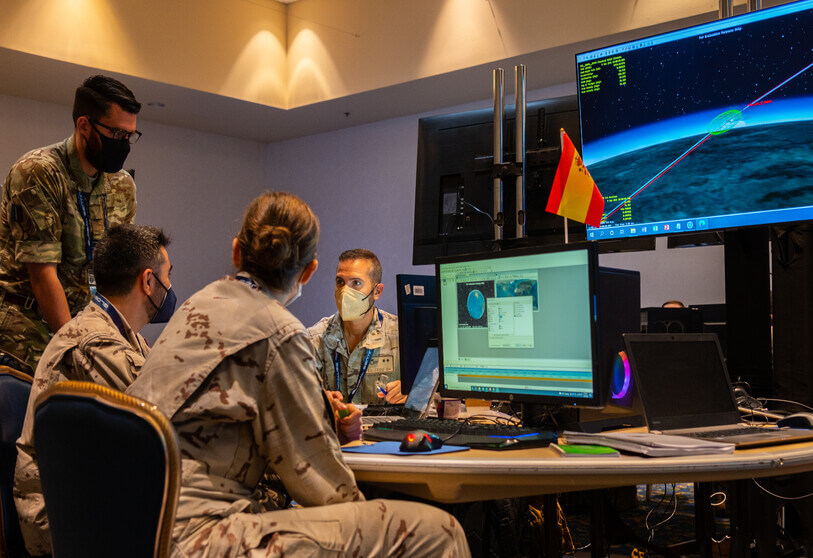
Spain and 23 other countries coordinate space control with the US Space Command | Atalayar
The Spanish Air and Space Forces were one of 25 air forces from four continents that participated in The largest multinational training exercise dedicated to monitoring the space environment.
The national presence was provided by agents from the Center for Space Control Operations (COVE)whose tasks are to supervise and control outer space within the framework of the National Space Monitoring and Tracking System or S3T (Spanish Space Tracking and Monitoring), monitoring and cataloging objects in orbit around the Earth and analyzing threats from space.

COVE maintains cooperative relations with NATO, the European Union and the United States, some of whose personnel have led to participate in Global Sentinel 22. The exercise, led by Washington Space Command and led by Lt. Gen. James Dickinson, 60, brought together about 150 pilots at Vandenberg Space Base in California who are dedicated to monitoring what’s happening in space in their nations.
In addition to military personnel from the host country, teams from 13 other NATO countries Germany, Belgium, Canada, Spain, France, Greece, Italy, Norway, the Netherlands, Poland, Portugal, Romania and the United Kingdom – the two NATO candidate countries, Sweden and Finland, participated.
Aerospace control technicians are among Washington’s strongest allies in Asia. South Korea, Israel, Japan, Thailand – and in Oceania, Australia and New ZealandShe was present, too. in latin america, Brazil and Peru, whose armed forces have control centers in their satellites for reconnaissance and surveillance, were present, but Chile was conspicuous by its absence. There was a team from Ukraine, but none from an African country.

Improve interoperability and space security
The annual Global Sentinel exercises aim to increase the interoperability of space operations among the armed forces that have signed cooperation agreements with the Pentagon to monitor the space environment, As is the case with the Spanish armed forces and those of the countries mentioned above.
The goal is to improve the cooperation and training of users of the ground segment dedicated to the continuous inspection of the space environmentas well as coordinating actions that govern their code of conduct and data transfer.

In summarizing, Each edition of Global Sentinel aims to update and share knowledge in order to increase security and provide similar answers In real situations of international cooperation in the face of risks or threats in the operation of space systems.
Military units invited to participate in the training, including the Spanish COVE, sent teams of four to half a dozen highly qualified officers and non-commissioned officers, who had to participate, follow and respond to the eight different scenarios presented to them.
Dividing the nation, they encountered a wide variety of operational situations with satellites, spacecraft, and various objects in space, both cooperatively and on a national basis. They also established eight regional space operations centers to facilitate the integration of multinational teams.

Develop knowledge sharing about software tools
They all had to solve the simulations “Attack and deny satellite services, detect electronic warfare attacks, mitigate deliberate actions against terrestrial infrastructure, and communications disruptions caused by solar storms”. They also resolved incidents of controlled and uncontrolled re-entry of spacecraft to the atmosphere, assessed the risks of space debris on satellite collision paths and various types of maneuvers of platforms and towers in orbit.
U.S. liaison officers expanded participants’ expertise in using aviation software. This is the case for the STK (Systems Toolkit), a tool used by the space and civil defense community on a global scale for analyzes and computations on orbital, interplanetary and interplanetary missions and orbital collision prevention.

The presence of Spanish military personnel on the Global Sentinel has occurred in previous years and is expected to continue. COVE is scheduled to reach full operational capability in June 2023 and its DNA includes ongoing training. Established in 2021, the center, “because of its high disruptive potential,” has acquired “great importance,” as space assets “constitute a vital infrastructure on which the country’s security is based,” explained General Juan Francisco Sanz, head of Defense Minister Margarita’s Flight Control and Control System. Robles during his first visit to the center.
The 2022 edition of the Global Sentinel was held from July 25 to August 3 at the Combined Space Operations Center (CSpOC), an organization of the space component of the US Space Forces Combined Forces Space Component (CFSCC). The exercise’s senior command was assigned to Major General Air Force Maj. Gen. Diana Burt, chief of the CCSOCF.

At the head of a group of 17,000 soldiers, General Diana Burt, 53, for nearly two years through August 22, was ultimately responsible for planning, integrating, directing and evaluating the United States’ joint and joint space operations.. She was also responsible for coordinating space traffic management, operating the GPS navigation system, and making military satellite communications available to senior American combat leaders and their allies.
To take a higher position in the Pentagon Space Forces, General Diana Burt was relieved less than a week ago by Major General Douglas Chase, 52who until then was the head of space operations and the right-hand man for General Dickinson.

“Organizer. Social media geek. General communicator. Bacon scholar. Proud pop culture trailblazer.”
